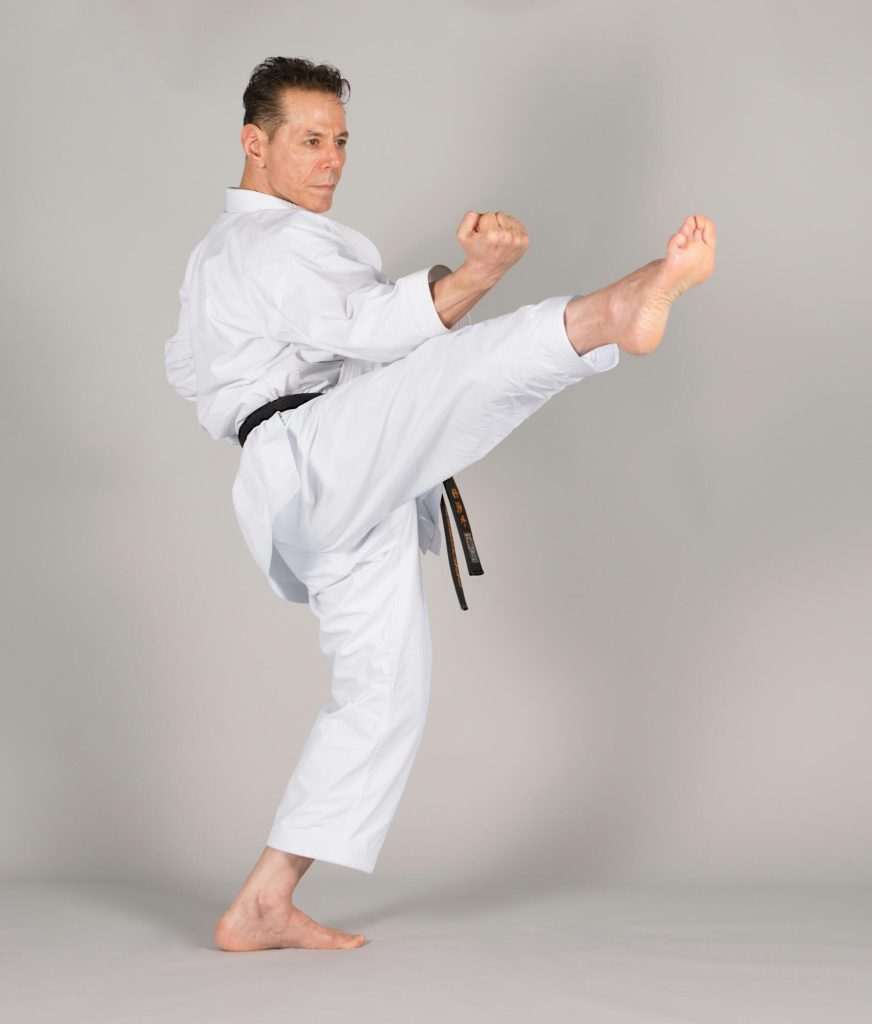Choosing the right martial arts clothing can make a significant difference in your training performance. While it might seem trivial, the proper attire does not just reflect tradition; it serves practical purposes that enhance comfort, focus, and overall effectiveness in your practice.
From safety to freedom of movement, the right martial arts gear sets the stage for a successful training session. Let’s explore to know more.
Essential Types of Martial Arts Clothing
Every martial artist knows the significance of the right gear. Whether you’re a novice or a seasoned practitioner, selecting the appropriate martial arts clothing can greatly influence your performance. Here are some of the types of martial arts clothing that every enthusiast should consider.
1. Gi (Karate Uniform)
The gi, especially recognized in karate practices, is synonymous with martial arts. This traditional outfit is designed for both performance and durability.
Crafted from cotton or a cotton blend, it allows for breathability while maintaining resilience during rigorous training sessions. Most karate practitioners will likely start their journey with a simple gi, but the variations available can cater to every skill level.
2. Taekwondo Dobok
The taekwondo dobok is distinctly different from the traditional gi. With a more modern fit and often made from lighter materials, the dobok allows for high kicks and swift movements typical in taekwondo. This outfit also features a v-neck design and often comes with a belt for ranking, promoting a sense of achievement as practitioners advance in their skills.
3. Jiu-Jitsu Gi
A jiu-jitsu gi is thicker and more durable than the standard karate gi, designed to withstand the grapple-heavy nature of Brazilian jiu-jitsu. These uniforms often have reinforced stitching to handle intense pulling and tugging during ground fighting. Practitioners of jiu-jitsu value the versatility in designing their attire, some prefer a more fitted look, while others go for looser styles.
4. MMA Gear
Mixed martial arts (MMA) gear includes a range of clothing types, such as rash guards, fight shorts, and grappling tights. Rash guards, made from polyester and spandex, provide a snug fit and help prevent skin irritation during sparring. These items are essential for any MMA practitioner intending to train or compete, ensuring they are protected while maximizing performance.
5. Kung Fu Uniforms
Kung fu uniforms highlight the artistry of this martial art form. Traditional styles include loose-fitting pants and jackets, often adorned with unique motifs.
These uniforms emphasize freedom of movement and are often made from silk or lightweight cotton. Their traditional nature reflects the cultural heritage of kung fu, creating a solemn aesthetic in practice.
6. Kickboxing Attire
Kickboxing enthusiasts typically favor a blend of style and functionality. Lightweight shorts, often with an elastic waistband, allow for mobility and comfort.
Many practitioners choose to wear fitted tops or tank tops to keep cool during intense workouts. Select kickboxing gear that allows freedom of movement while showcasing personal style.
7. Sparring Gear
While sparring gear is primarily about safety, it must also be comfortable and functional. Essential items include headgear, mouthguards, and gloves.
Invest in high-quality sparring gear to protect yourself and perform at your best. Many brands provide options focusing on both safety features and comfort, allowing for freedom of movement while minimizing injury risk.
8. Compression Wear
Compression wear has gained popularity among martial artists looking to enhance performance and recovery. This type of martial arts clothing supports blood circulation and helps regulate body temperature. Items such as leggings, sleeves, and tops can be beneficial during intense training sessions, providing support to muscles while aiding in recovery afterward.
9. Rash Guards
Rash guards serve both functional and protective purposes for those practicing ground-based martial arts. Often made with moisture-wicking technology, they help keep practitioners dry during training.
Rash guards are crucial for preventing chafing and sunburn, especially during outdoor training sessions. The snug fit also allows ease of movement, making it an essential piece of equipment for any serious martial artist.
10. Training Shoes
While many martial arts can be practiced barefoot, specific forms, especially those involving heavy footwork like taekwondo or kickboxing, may benefit from specialized training shoes. These shoes provide traction and support, allowing for quick movements. Choosing a lightweight shoe that won’t impede movement is essential for a successful workout.
11. Traditional Karate Uniforms
For those looking to embrace their heritage in martial arts, traditional karate uniforms offer a link to the cultural roots of the discipline. These back-to-the-basics outfits prioritize comfort and authenticity over style trends. Made from heavy cotton, they can withstand the rigors of training, ensuring that practitioners feel as connected as ever to their practice.
Why Martial Arts Clothing Matters
Choosing the right martial arts clothing is crucial for anyone serious about their training. This post details tips to help you select the best martial arts clothing for your needs, ensuring that you feel confident and capable on the mat.
1. Understand Your Discipline
The first step in selecting martial arts clothing is understanding the specific requirements of your discipline. Various types of martial arts, such as Brazilian Jiu-Jitsu, Taekwondo, or Muay Thai, have their own styles of uniforms that serve different functional purposes.
For instance, Brazilian Jiu-Jitsu practitioners typically wear gi that are made from sturdy material, allowing for durability against abrasions. On the other hand, Taekwondo practitioners wear lighter materials that support high kicks. Knowing the requirements of your chosen martial art will help you narrow down your options effectively.
2. Focus on Fit
When it comes to martial arts clothing, the fit matters most. Your gear should be snug enough to stay in place but loose enough to let you move freely. If your uniform doesn’t fit well, it can make training harder and even increase the risk of injury.
Always try on uniforms or check the sizing chart before buying. Sizes can vary between brands, so double-checking helps you find the best fit. The right size makes a big difference, letting your clothing support your movements instead of holding you back.
3. Opt for Quality Materials
Consider the fabric when selecting martial arts clothing. High-quality materials such as cotton or a cotton blend offer breathability and comfort, which are crucial during extended training sessions. Synthetic materials like polyester or moisture-wicking fabrics can also be beneficial, especially for high-intensity workouts.
Additionally, look for clothing that is durable and can withstand the rigors of training. Investing in quality fabrics may initially seem costly, but the long-term benefits-like longevity and performance-are worth it.
4. Take Climate into Account
The climate where you practice martial arts plays a significant role in your clothing choice. In warmer climates, opt for lighter fabrics that allow air circulation to keep you cool. On the other hand, if you train in a cooler environment, consider layering your clothing.
For instance, certain martial arts clothing brands offer lightweight long-sleeve tops that can be worn in cooler weather without being too heavy. Always consider the temperature and adjust your martial arts clothing accordingly to ensure optimal comfort.
5. Look for Functionality
Functionality should be at the forefront when selecting martial arts clothing. Features such as adjustable waistbands, reinforced stitching, and pockets for essentials can simplify your training experience. Other functional elements might include loops for your belt, which will prevent it from slipping during practice.
Evaluate your personal needs based on your training habits. If you prefer to keep your belongings close while training, select clothing with adequate pocket space. Remember, additional functionalities contribute to better overall performance.
6. Check for Proper Certification
Different martial arts associations may have specific uniform regulations. To ensure compliance, check whether your chosen clothing meets these standards. For example, you may check traditional karate uniforms that often have distinct color and fabric specifications that are important.
By adhering to these requirements, you ensure that your uniform reflects your dedication and respects the traditions of the art. Checking for proper certification can save you from facing any potential embarrassment at competitions or dojos.
7. Personalization and Style
Your martial arts clothing can represent your personality and dedication to the art. Many brands offer options to customize your uniforms, be it through personalized patches, embroidery, or color choices. Personalization can create a sense of pride and identity in your training.
However, ensure that any personalization does not interfere with the functionality of the clothing. For example, avoid placing heavy patches on areas that may restrict movement during techniques.
8. Consider the Cost
While it’s tempting to invest in the top-of-the-line martial arts clothing, assessing your budget is crucial. Look for a balance between quality and affordability without compromising performance and comfort. Sometimes, mid-range brands offer clothing that meets your needs without breaking the bank.
It’s advisable to compare different brands and their price points. Additionally, keep an eye out for sales and discounts. A great deal can lead to getting high-quality gear at a fraction of the cost.
Elevate Your Training Experience with the Right Martial Arts Clothing
Wearing the right martial arts clothing helps you perform better, stay comfortable, and focus during training. The right outfit not only keeps you safe but also boosts your confidence, making your practice more enjoyable and effective. Keep these things in mind when choosing your next martial arts uniform, and you’ll notice how it improves your training experience.
Invest in your martial arts journey by getting the proper gear. The right clothing helps you move easily, train harder, and stay motivated as you work toward success in your martial arts goals.
Looking for more tips and advice? You’re in the right place! Make sure to bookmark our page and come back to check out more interesting articles.







